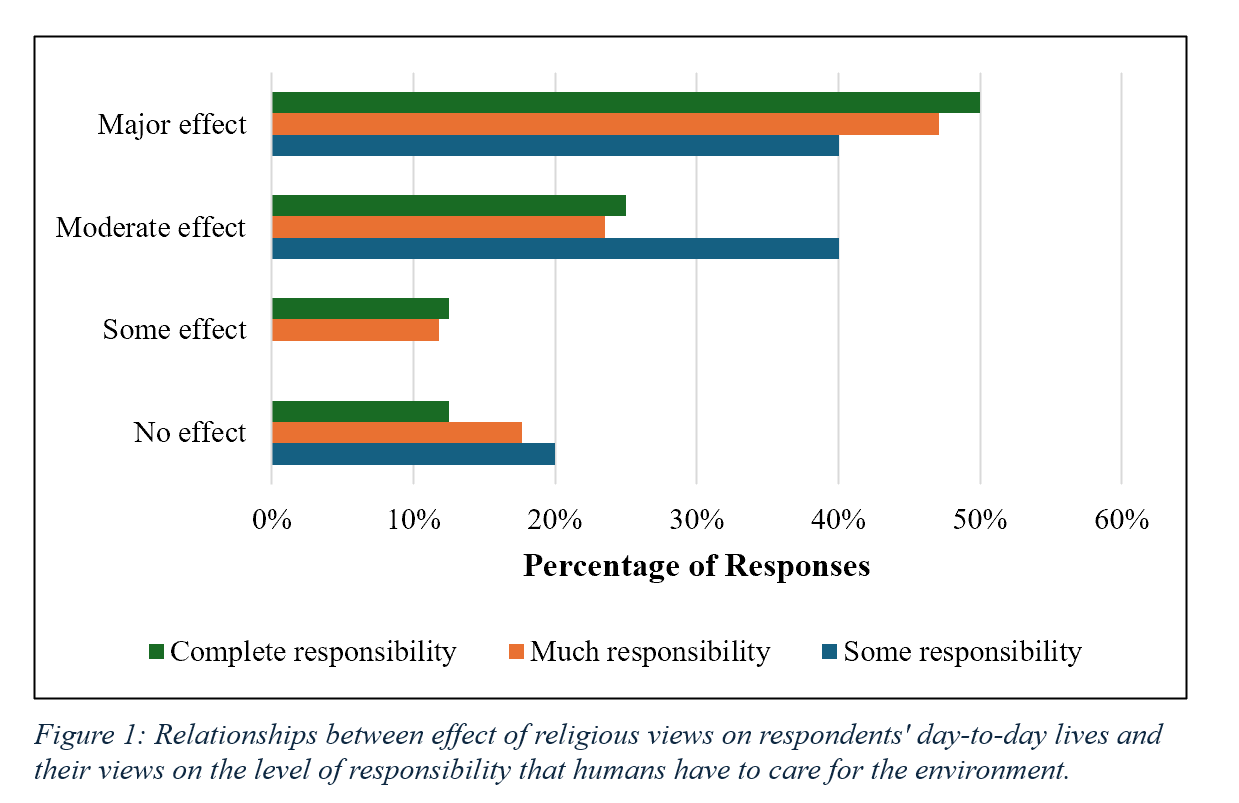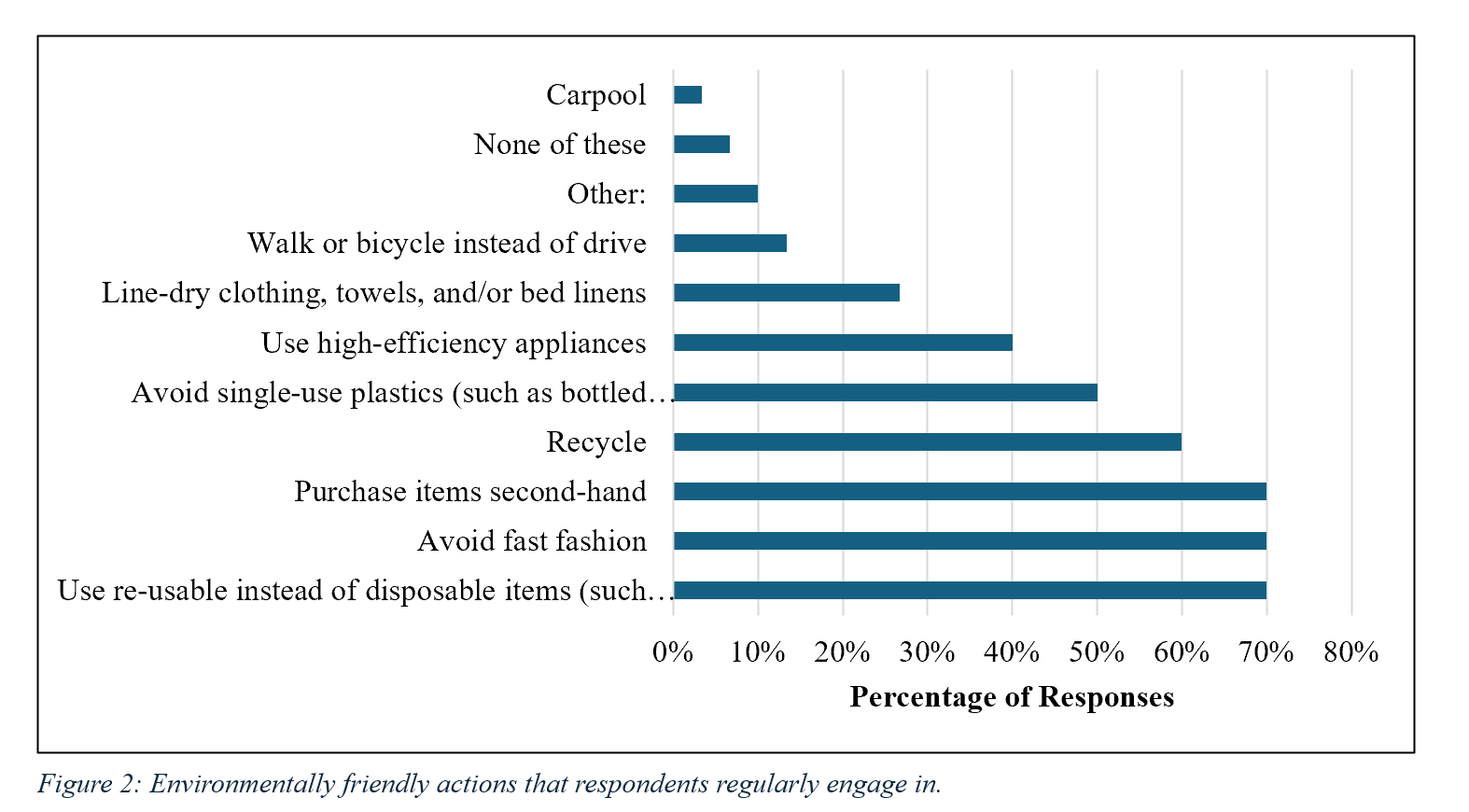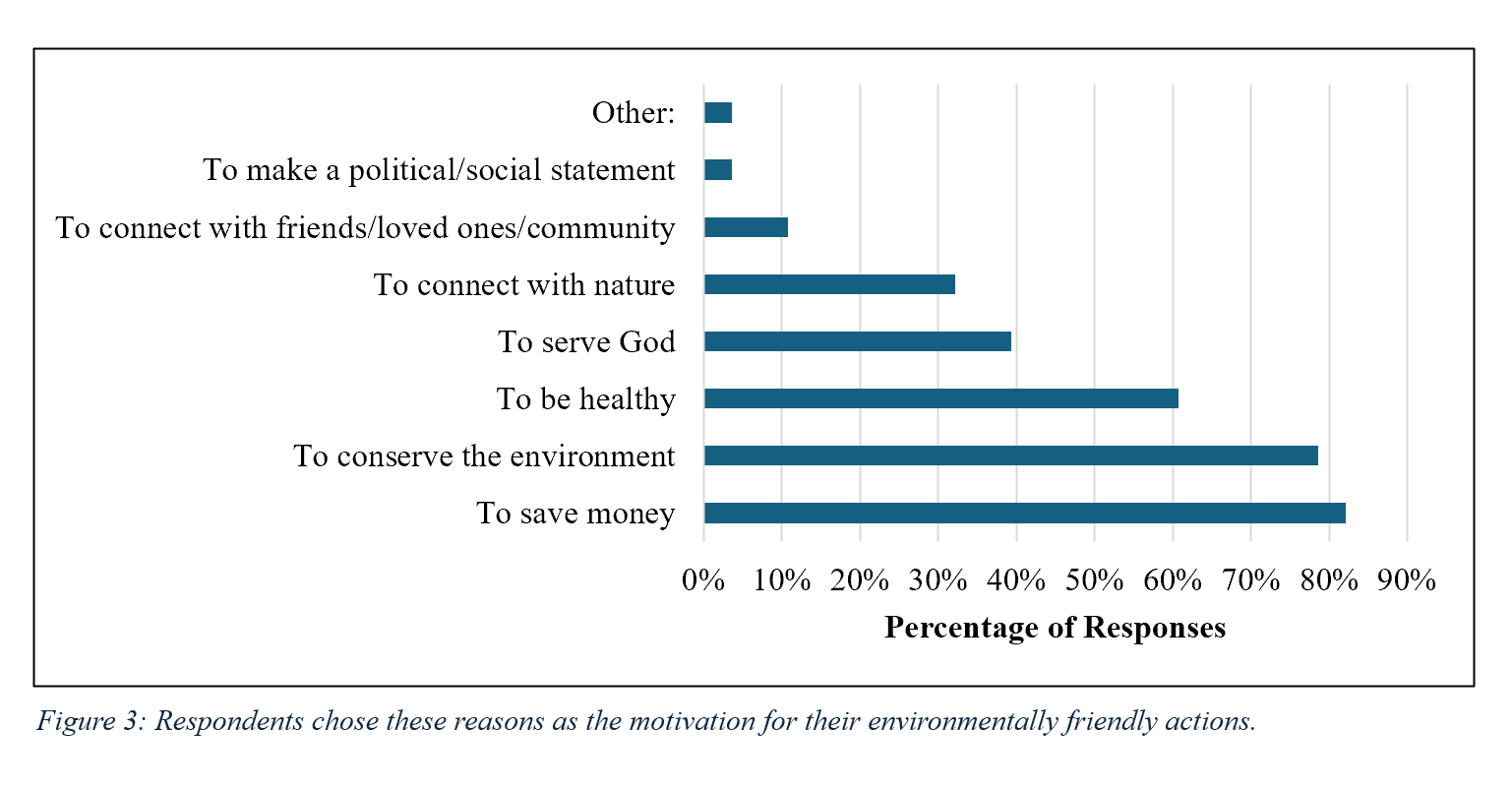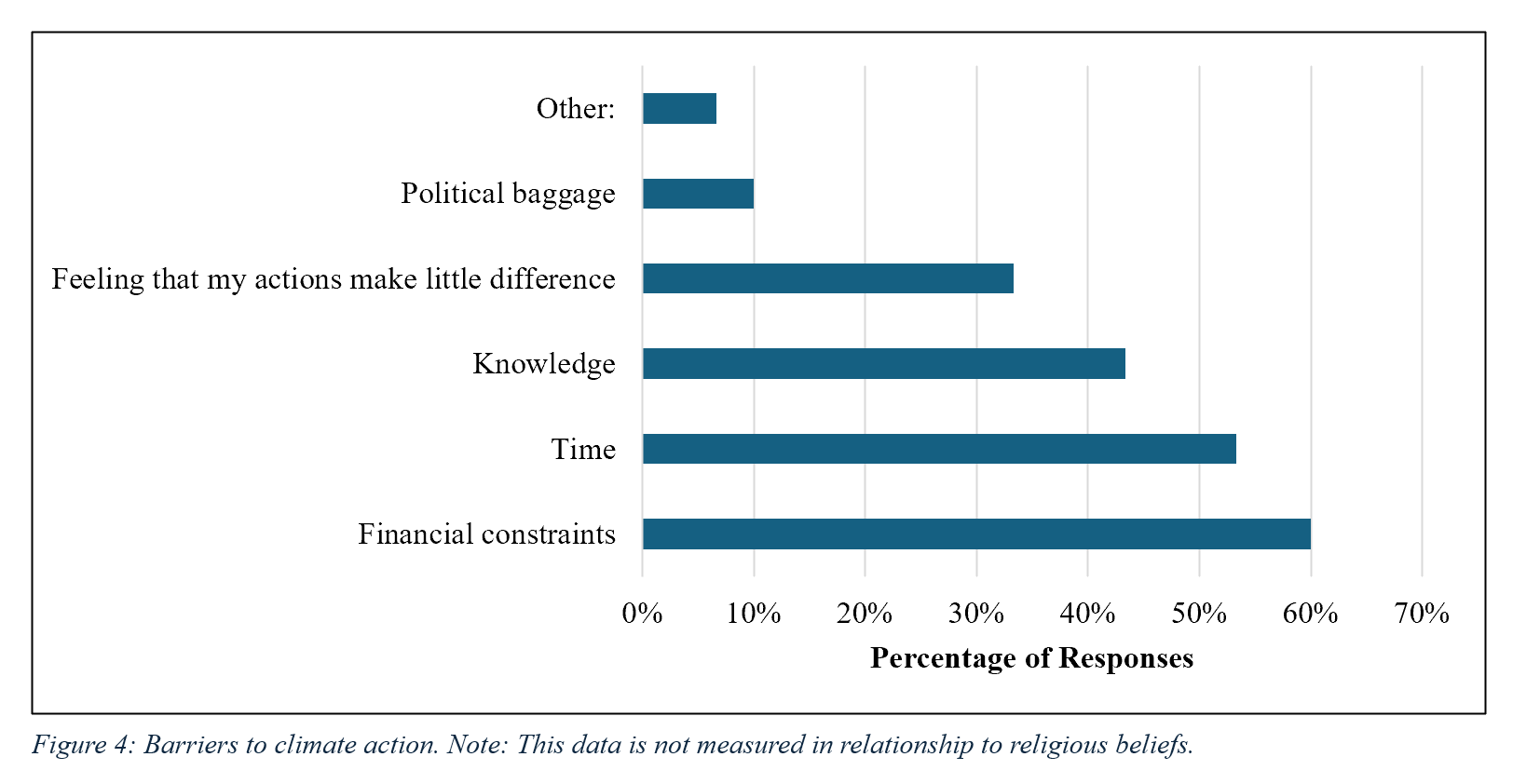49 Naomi Staller – Can Heaven Save the Real World? Connecting Religion and Environmental Conservation
Naomi Staller (she/her/hers) is a Senior from Huntertown, IN majoring in English. This work was prepared for Emmy Price’s ENG W230, who states, “Naomi’s research evaluates a powerful and often overlooked connection between faith and environmental action. While exploring if religious beliefs motivate individuals to engage in environmentally friendly actions, Naomi addressed her research with a thoughtful, inclusive approach. This work has the potential to broaden the conversation around sustainability and the environment.”
Can Heaven Save the Real World? Connecting Religion and Environmental Conservation
Abstract
Through recent decades, the earth’s climate has continued to change, causing an increased number of harmful events and catastrophic disasters. Overwhelmingly, scientific evidence points to human activity as the primary cause of these climate changes. As such, addressing and reversing these trends also requires human efforts. This research project investigates whether a connection exists between religious belief and environmental action. Data collected through an online survey shows that higher religious devotion is positively correlated with increased belief in human responsibility to the natural environment. Additionally, highly religious persons are most likely to engage in environmentally friendly behaviors. However, survey respondents attributed these actions primarily to other factors besides their religion. These insights show that religious persons can be—and already are—engaged in environmentally friendly efforts, but that religious belief alone is not the cause of these efforts.
Introduction
Through recent decades, scientists and researchers have shared extensive evidence that the earth’s climate is changing in ways that are harmful for the planet and the life it sustains. Many world governments, both individually and cooperatively, have acted to address this issue, forming the United Nations Framework Convention on Climate Change, pledging to work toward mitigating human’s effects on the natural environment, and meeting annually to revisit and update their progress on their goals. Non-governmental organizations have also formed to research climate change, raise awareness on the issue, and promote climate action at the local and global level. However, for many people, these efforts feel distant and removed from their daily lives. Therefore, this paper investigates the potential of religious beliefs and networks to motivate, engage, and fortify local climate efforts. With data gathered from an online survey, we are now able to identify what motivates—and what hinders—environmental action amongst religious peoples.
Materials and Methods
Materials and Design
To research the connection between religious belief and environmental action, I used Qualtrics (with whom Indiana University is partnered) to create a 16-question survey which included both multiple-choice questions (with more than one answer where applicable) and Likert scales. The first four questions gathered demographic data, and the remaining twelve measured religious and environmental beliefs and actions. Independent variables that were measured included age, ethnic background, educational background, and religious background. Dependent variables included current religious affiliation, beliefs regarding climate responsibility, and environmentally friendly actions.
Once complete, the survey was distributed via Snapchat, Facebook, and Instagram. The group amongst whom the survey was distributed comprised primarily my (the researcher’s) friends, family, and acquaintances, but it may have reached further audiences if shared by this primary audience. While this survey pool is somewhat homogeneous, the group does contain a variety of ages, education levels, socioeconomic statuses, ethnicities, genders, and global locations. Participants were required to be at least 18 years old and were notified that their responses would be anonymous. Over the course of five days, 34 complete responses were gathered.
Analysis
To analyze the data gathered by the survey, I used tools provided by Qualtrics. Measurements and relationships of primary concern included the extent to which respondents’ religious beliefs affect their day-to-day lives and their engagement with climate friendly actions. Other supporting factors were weighed as well, such as respondents’ beliefs on who is responsible for the natural world, their views on climate change, and any barriers or catalysts that affect their involvement with environmental conservation. These analyses yielded several important insights.
Results
Overview
The research gathered from my survey supports my hypothesis that a connection exists between religious belief and climate action. Those whose religion has a significant effect on their daily lives are more likely to believe that human beings have much or complete responsibility to preserve the natural environment. Additionally, they are overall more likely than those who report that their religion has a minor impact on their lives to perform environmentally friendly actions in 7 of 10 categories. However, it is worth noting that their religion is not the primary motivation for this group’s environmentally friendly actions as discussed below.
Main Findings
The religious affiliation of this question’s 33 respondents is as follows: Christianity (21), no religion (9), other (2), and Judaism (1). Figure 1 shows that those whose religious views have a major effect on their day-to-day lives, followed by those whose religion has a moderate effect, are most likely to view the natural environment as the responsibility of human beings.

Additionally, those who engage in environmentally friendly actions (Figure 2) are more likely to report that their religion has a major effect on their daily lives.

However, respondents did not attribute their conservation efforts primarily to their religious views but to other practical concerns as shown in Figure 3.

Catalysts and Barriers
To pivot from the group addressed above, respondents who believe it is humanity’s responsibility to care for the natural environment cite “concern for future generations” as their primary catalyst, followed by the connection between the natural world’s and humanity’s well-being, belief that God wants us to care for his creation, and concern for the present generation. Their primary barriers (Figure 4) are financial constraints and a lack of time.

Discussion
The results of this study show that religious belief is correlated with environmental action, but it is not the cause of it. Religious people are more likely than others to believe that human beings are responsible for the natural environment, but they do not credit their religious beliefs with being the primary catalyst for the environmentally friendly choices they make in their daily lives. To phrase it another way, highly religious people are more likely to engage in environmentally friendly actions but their primary reasons for doing so do not involve their religious beliefs or concern for the natural world.
These results do not mean that governments and environmental organizations cannot appeal to a religious person’s beliefs to engage them in conservation efforts. On the contrary, the research shows a positive correlation between religious beliefs, pro-environmental beliefs, and environmentally friendly actions. The research also shows that the primary barriers for conservation efforts amongst religious people are financial constraints and time (Figure 4) as opposed to a lack of concern and a lack of confidence in one’s ability to make a difference as argued by Latkin et al. (2023). What should be considered by those who would engage religious groups in conservation efforts is that appeals for engagement would be most effective if religious motivators were coupled with other practical factors such as lowered costs and improved physical health. This supports the argument made by Leite, Lopes, and Pereira (2023) that positive action results from a fine balance of anxiety for a problem and hope for the future, both of which are felt by and can, in turn, mobilize religious people.
While this study offers valuable insights, it does have some limitations. First, the survey pool was relatively small and homogeneous. A more robust survey group would enhance this research. Another limitation is that the broad scope of the project’s religion aspect precludes deeper insights into specific sects or denominations of the various belief systems. Finally, one metric that was not measured was direct involvement in religious organizations such as church attendance, volunteering, or community outreach. This could be an area of focus for future research along with the connections between political alignment, religious values, and environmental concerns.
Conclusion
As the climate crisis worsens, it is essential that all humanity work together to conserve and protect the natural environment. In addition to governments and environmental organizations, religious groups—with their unique combination of concern for society and the earth, their hope that the future can get better, and their community networks—can provide significant support for climate initiatives. While this project shows that other factors besides religious belief are the primary catalysts for their environmentally friendly efforts, this research also shows that religious people are most likely to engage in those efforts, even if they do not credit their religious views with being their primary motivator. Those primary motivators (and barriers) include financial resources, time, and health. To conclude, heaven can save the real world, but it may need to partner with earthly elements to do so.
References
Latkin C, Dayton L, Bonneau H, Bhaktaram A, Ross J, Puge J, Weil Latshaw M. 2023. Perceived barriers to climate change activism behaviors in the United States among individuals highly concerned about climate change. Journal of Prevention. [ProQuest]. 44:389-407. [Cited 8 December 2024]. Available from: https://doi.org/10.1007/s10935-022-00704-0
Leite A, Lopes D, Pereira L. 2023. Pro-environmental behavior and climate change anxiety, perception, hope, and despair according to political orientation. Behavioral Sciences. [ProQuest]. 13:966. [Cited 8 December 2024]. Available from: https://doi.org/10.3390/bs13120966
Media Attributions
- Naomi pic 1
- Naomi pic 2
- Naomi pic 3
- Naomi pic 4
